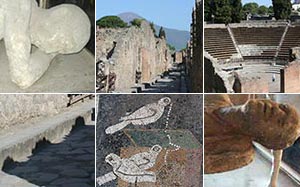Pompeii
 Photos courtesy of volunteer Luis Salavarria |
One of the most famous volcanic events in history occurred in Italy in 79 CE. Vesuvius, a volcano located about 8 km (5 mi) north of Pompeii, Italy, erupted with minimal warning. Hot ash, cinders, poisonous gases, and other eruption debris rained down on the city in a pyroclastic surge, burying it under a layer 6 m (20 ft) deep. The nearby towns of Herculaneum and Stabiae were also destroyed.
The eruption happened so quickly and unexpectedly that the residents were taken by surprise. Some tried to flee, while others locked themselves in their houses for safety. Much of the city and about 2,000 residents were buried by the ash and debris, or suffocated by poisonous gases, often in the middle of activities such as fleeing. Pompeii disappeared, and the city became more of a legend as years went by.
Pompeii was rediscovered in the late 1500s, but it wasn’t until 1738 that excavation began, first at Herculaneum, and later, in 1748, at Pompeii. The excavations unearthed people in the positions they died in, possessions in place, intact buildings—all in all, like photographs from that time of the city and its residents.
This content has been re-published with permission from SEED. Copyright © 2025 Schlumberger Excellence in Education Development (SEED), Inc.

